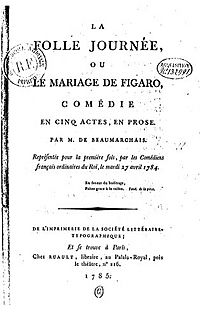The Marriage of Figaro (play) facts for kids
Quick facts for kids The Marriage of Figaro |
|
|---|---|

Title page of the first edition, 1785
|
|
| Written by | Pierre Beaumarchais |
| Characters | Figaro Suzanne Count Almaviva Countess Rosine Chérubin, etc. |
| Date of premiere | 27 April 1784 |
| Place of premiere | Théâtre Français Paris, France |
| Original language | French |
| Genre | Comedy |
| Setting | Count Almaviva's palace in Seville, Spain near the end of the 18th century |
The Mad Day, or The Marriage of Figaro is a famous play written by Pierre Beaumarchais. It is a comedy, which means it's a funny story with a happy ending. Beaumarchais wrote it in 1778, and it was first printed in 1785.
The play was first shown in Paris on April 27, 1784, at the Théâtre Français. It was a huge hit! The Marriage of Figaro is actually the second part of a story. It follows the play The Barber of Seville and comes before The Guilty Mother.
Contents
About the Play's Story
This play tells the story of Figaro and Suzanne. They are servants who want to get married. However, their boss, Count Almaviva, tries to stop them. He wants Suzanne for himself.
Main Characters in the Play
The story has several important characters.
- Figaro: A clever and resourceful servant.
- Suzanne: Figaro's smart and charming fiancée.
- Count Almaviva: The master of the house, who causes trouble.
- Countess Rosine: The Count's wife, who helps Figaro and Suzanne.
- Chérubin: A young pageboy who gets into funny situations.
Where and When the Story Happens
The play takes place in the Count Almaviva's grand palace. This palace is located in Seville, Spain. The story happens near the end of the 18th century.
Why This Play Is Important
The Marriage of Figaro was very popular. It made people laugh and think. The play showed how ordinary people could outsmart powerful nobles. This idea was quite new and exciting for its time.
From Play to Opera
The play was so famous that it inspired a very well-known opera.
- The Marriage of Figaro (1786) is an opera created by Mozart. It is based on Beaumarchais's play.
Images for kids
See also
 In Spanish: Las bodas de Fígaro (teatro) para niños
In Spanish: Las bodas de Fígaro (teatro) para niños





